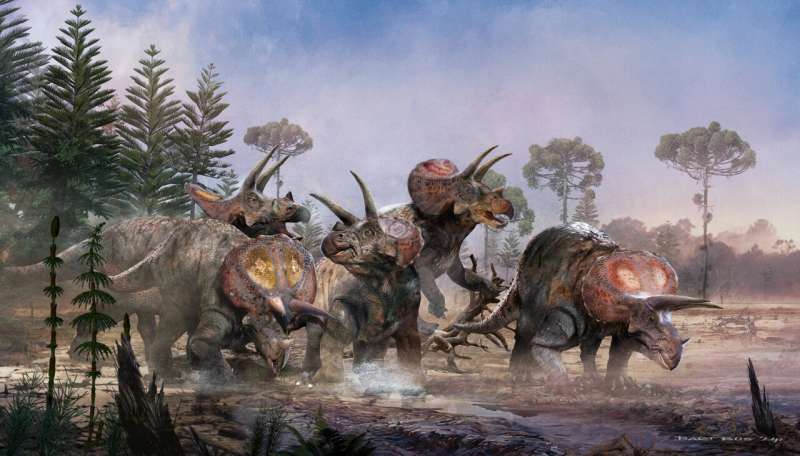This article has been reviewed according to Science X's editorial process and policies. Editors have highlighted the following attributes while ensuring the content's credibility:
fact-checked
proofread
Research shows that five three-horned dinosaurs lived, and died, together

A team from Naturalis Biodiversity Center in the Netherlands was looking for a Tyrannosaurus in the summer of 2013 in Wyoming. Instead, they found a Triceratops: the famous dinosaur with the three horns and the large neck frill. And then they found another one. And another one. And more. The dig turned into a project that would last for more than 10 years.
All in all, they dug up 1,200 bones and bone fragments, of at least five individuals. A team of professional and volunteer paleontologists and technicians spent years removing them from the quarry.
A researcher was hired to study the fossils: how did these dead dinosaurs end up there, together? What do their bones tell us of their lives and their deaths?
"The material is of very good quality," De Rooij reflects on the dino detective story that is his Ph.D. thesis. "This enabled us to show that these triceratops grew really slowly, for instance." The details of the bonebed indicate that the five dinosaurs died together, possibly mired in a swamp. They are in a thin layer of rock, without bones of other species.
Research into the physical and chemical properties of the hundreds of triceratops teeth tells of a migratory existence—one that was the same for all five of the dinos. In other words: this species of dinosaur teamed up, at least occasionally. "And that of course leads to all kinds of new questions," De Rooij says, "How complex was this social behavior, exactly?"
De Rooij's supervisor, Prof. Anne Schulp (Naturalis/Utrecht University), is very happy about the entire trajectory from dig to defense ceremony.
"Naturalis, the national natural history museum of the Netherlands, now has the biggest triceratops find in the world, and Utrecht University has the first Dr. Triceratops in the Netherlands. De Rooij's work didn't just result in research papers, but also in an exhibition about his findings. As of October, the exhibition will kick off at Naturalis—and kick off the world tour—where the five triceratops are shown as they lived and died 67 million years ago: together."
More information: Bringing fossils back to Life—new insights on the biology of the iconic dinosaur Triceratops
Provided by Naturalis Biodiversity Center




















